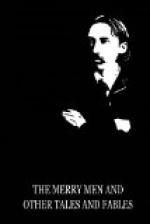|
This section contains 2,200 words (approx. 8 pages at 300 words per page) |

|
SOURCE: Menikoff, Barry. “Introduction: Fable, Fiction, and Modernism.” In Robert Louis Stevenson: Tales from the Prince of Storytellers, pp. 29–35. Evanston, IL: Northwestern University Press, 1993.
In the following excerpt, Menikoff discourses upon “Markheim” as an allegory for “the struggle of good and evil for the heart of man.”
Unquestionably the single story that most exemplifies duality in man, apart from Jekyll and Hyde, is “Markheim,” originally published as part of a collection of “horror” stories in a volume titled The Broken Shaft. Stevenson used the form to focus attention on the divided self, and its implications for behavior and conscience. It is a story brilliant in its simplicity, its movement, and its psychological acuity. Markheim, a youngish man who has steadily resorted to more serious crimes as a result of his gambling debts, enters an antique dealer's shop on Christmas eve, engages the flinty old man in conversation, then...
|
This section contains 2,200 words (approx. 8 pages at 300 words per page) |

|


